Grading Justin Forsett's 2014 game tape ... with Justin Forsett

I first met Justin Forsett when he was a bit player in Seattle's offense, making his way with a new coaching staff. It was 2010, Pete Carroll's first year with the Seahawks, and my first year as a beat reporter. Forsett was a third-year player, a seventh-round pick in the 2008 draft. I was looking for a player who would do a series of training camp pieces when I really didn't know anybody, and Forsett was kind enough to do so. Through his time with Seattle, which ended after the 2011 season, and into his stints with the Texans and Jaguars, I never forgot that kindness.
Meanwhile, Forsett was struggling. He never gained more than 619 yards in a season in Seattle, while his former Cal teammate Marshawn Lynch took the city by storm. He gained 374 yards and scored one touchdown for the Texans in 2012 and followed that with 31 yards on just six carries for the Jaguars in 2013. When the Ravens signed him after his release from Jacksonville in April 2014, it was a move that barely made a blip around the NFL. Forsett hadn't started a game since 2010, and he was playing on a one-year, $730,000 contract. It was thought that he would be a minor contributor, a guy familiar with the offensive system he'd learned in Houston when Gary Kubiak was the team's head coach. Kubiak was now Baltimore's offensive coordinator, and it was he who stood up for Forsett.
Player profiles: Ravens' draft proves they're all in on RB Justin Forsett
Once he got to Baltimore, a few things happened. Ray Rice's NFL career came down hard in a hail of controversy. Bernard Pierce got hurt. Lorenzo Taliaferro was a rookie, albeit a promising one. After spending the first month of the season in a backfield rotation, Forsett broke out and made a definitive statement that he was the man to start. And in 2014, he had by far his best season. He rushed for 1,266 yards and eight touchdowns on 235 carries, and his 5.4 yards per carry average led all qualifying running backs. He added 44 receptions for 263 yards for good measure, and became the balm the team needed after the Rice disaster—both on and off the field.
Less than a year after the Ravens brought in Forsett, they re-signed him to a three-year, $9 million deal that made him the team's primary back for the foreseeable future. The most amazing part of his story is that it almost didn't happen. When I talked to Forsett this week, he told me that after the Jaguars cut him, he was just about done.
“We had a few teams reach out, but nothing serious,” Forsett says. “Baltimore had called because of the Kubiak connection, but they were very slow talks. So, I continued to work out, and continued to look into other possible careers if I was done. The future was kind of bleak at that time.”
But Kubiak remembered a player who always put forth his best effort, and that turned out to be Forsett's saving grace.
• KLEMKO: Clock ticking on Wilson negotiations | MMQB's camp blog
Ranking NFL's top 10 running backs heading into 2015 season
“When I was in Houston, I was just one of those hard-working guys,” Forsett says. “Made sure I put my best foot forward on the field, and tried to be a leader inside the locker room and on the field. Coach took a liking to it, and I remember him saying right before I left to go to Jacksonville that he was proud of me, and if there was ever an opportunity for me to play for him again, he was open to it. That I could always play on his team. And he kept his word—I got released by Jacksonville, and he was right there, standing on the table to get me in.
“It was early on that I figured I was going to get an opportunity to show what I could do, just because of the Ray Rice situation, and some injuries to some other guys. So I had to take more of the load and got a chance to start the first couple of games. I knew it could be special, but I could have never written the story this way. Seven years down the road, getting a shot like that, and being able to run with it.”
For this piece, Forsett agreed to analyze five of his plays from the 2014 season with me for a deeper dive into how he turned it all around in a system that's perfect for his skill set.
• Farrar: Free-agent guard Evan Mathis grades his own tape from 2014
Play No. 1: Week 13 vs. Chargers, 3:03 2Q
SI: In the Marshal Yanda spot for the NFL's Top 100 series, you talked about this 23-yard run against the Chargers where Yanda blocked three guys on the same play. What are the characteristics that make Yanda so great? And what were your overall thoughts when you got to Baltimore and saw the line that would be blocking for you? For one thing, you've got two tight ends to the right, so I assume you're thinking, “Boom, here we go to the right side.”
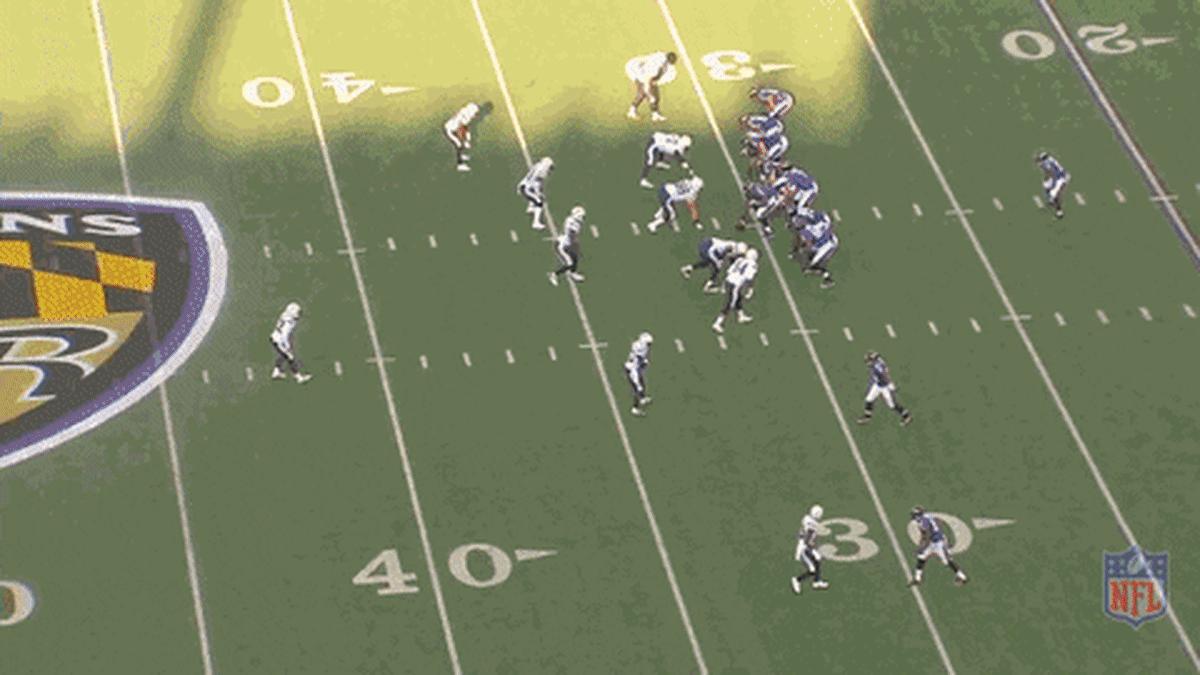
Forsett: Yeah. So that play, it's outside zone to the right, toward Marshal. And usually, I'm trying to be as patient as possible, because I have two tight ends on the side. So, I know I've got some extra help. Now, what Marshal does—he's such a phenomenal player—he's able to do his job, help out another guy and get some extra work at the next level. The whole scheme is just to be patient, and let the guys work in front of you—set them up, and Marshal makes my read pretty easy on this play.
N.Y. to TEN to CIN and back: Preview of our 2015 NFL training camp tour
SI: This is one of many examples where you show such patience waiting for the gaps to open, and you'll hear about younger backs outrunning their protection before they understand how to do it. I think a lot of guys might have cut back to the left where Melvin Ingram, No. 54, was closing in. Because it's a more obvious gap. But you bided your time and reaped the benefits. How did you develop the confidence to avoid balking, to stay with your assignments?
Forsett: It's just over time. I remember when I was in Seattle in 2009, and we brought in the [zone-blocking] scheme with [offensive coordinator] Greg Knapp, and they were kinda worried I wouldn't be able to fit into it at first. Because I was doing a lot of shaking and extra movement, and over time, I was able to understand how the scheme works. You get reps in it, and you get a better feel for it. I've been in it for a while now, and you've got to know. You've got to feel comfortable with it.
SI: What were your overall thoughts when you saw the line that would be blocking for you?
Forsett: It was exciting, man. What I love is that we have some nasty guys who are willing to get dirty and physical on every play. Anytime you have that mentality, you know you're going to have a good offensive line.
SI: What is it about that Alex Gibbs/Mike Shanahan/Gary Kubiak blocking system that almost predetermines success for running backs?
Forsett: What you do is you get the defensive line moving horizontally, and when you do that you create lanes, and it gives the running back options. It's your job to be patient, and pick and choose which way you want to go. Like I said, I have a comfort level in it, and you usually pick the right hole. I have a lot of reps in it, and I have a great offensive line that's going to cut those defensive linemen down and get them hesitant about running really fast.
• KING: All eyes on Adrian Peterson as 2015 NFL training camps open
Play No. 2: Week 17 vs. Browns, 2:48 1Q
SI: This was one of your few negative plays of the 2014 season—a three-yard loss in the red zone. What went wrong on this play?

Forsett: This is actually just a great play by the defense. We probably needed to call a timeout and go the opposite way, because they were loaded to my side [on a run blitz]. They've got more men than we have—it was a great call in the right situation. They get paid to play as well, and they made a great play.
Pete Carroll, NFL's eternal optimist, is ready to turn heartbreak into triumph
SI: It's an interesting discussion point because you have a lot of missed tackles caused for a player your size. Pro Football Focus has you with 32 missed tackles caused in your 274 attempts (including the playoffs), which is a very high percentage. What's your secret to breaking tackles and getting extra yards after first contact? How do you that so often at 5'8" and 195 pounds?
Forsett: It's just something I've had as long as I've played football. Coaches always told me, “Keep your feet moving, keep then running, try to stay balanced.” And when you have a low center of gravity like I do, that works to my advantage.
SI: Sure, but there are smaller backs who can't do what you do. You have to get small through the hole, but you have to maintain your speed and balance, as well. How do you do it?
Forsett: Yeah, body control ... I spend a lot of time working on my core, because I feel that if your core is at its peak, you're able to control everything else in your body movements. That's the center of everything, so I make sure I spend a lot of time on core stuff and ab workouts. Whatever it takes to make sure I'm able to make those little adjustments while on the run and not get off-balance.
Play No. 3: Week 14 vs. Dolphins, 4:46 4Q
SI: This 44-yard run against the Dolphins is a very good example of three primary attributes for any good running back: patience to wait for the gaps to open, speed through that first gap and acceleration in the second level. Last season, the Ravens ranked third in second level rushing yards, per Football Outsiders, and first in open field yards. You ranked third in the league with 19 runs of 15 yards or more, behind Marshawn Lynch and Eddie Lacy. I want to ask how do you develop speed to and through the hole, but first, take me through this play.

Forsett: This is another outside zone, running toward Yanda's side. He does another great job, opening another lane for me. What I am is keeping my landmark, and what I mean by that is that I'm staying on track. We have a track every time we do outside zone; it's usually the outside leg of the tight end. So I'm staying patient and not giving away any keys that I'm going to cut upfield. We continued to stretch the defense, and [the line] did a great job at the point of attack. Marshal Yanda sealed off the tackle, so it was a pretty easy read for me. It was one of those zone schemes where you stretch, and you get downhill. Even the center—even Jeremy Zuttah—was able to push his guy past me and create a lane. Everybody was doing their jobs."
Coming off brutal losses to end 2014, NFC coaches plot teams' comebacks
SI: It's a nice little split, because Yanda's pushing defensive tackle Jared Odrick inside, your tight end Owen Daniels is pushing end Cameron Wake outside, and Ricky Wagner, the right tackle, gets linebacker Philip Wheeler at the second level. So it's 1, 2, 3, and off you go. But again, it's still a matter of working with your blocks. I remember when Adrian Peterson came into the league, and it was a big thing for his first couple of years. He was outrunning his blocks, and as good as he was, he was even better when he learned to correct that.
Forsett: Yeah, it's about tempo. You can't be too fast, because you'll miss it, you'll miss a lot of holes. But like you said, it's not speed to the hole, it's speed through the hole. You've got to make sure you're setting up your blocks and being patient, knowing when to hit it and when not to."
Play No. 4: Week 10 vs. Titans, 13:17 4Q
SI: You did a lot of flare-outs from the backfield on passing plays last season, but this 35-yard touchdown pass to Torrey Smith against the Titans in Week 10 shows that you're pretty adept at blitz pickup, too. Tennessee sends the house on an A-gap blitz (a Ray Horton specialty), and you motion over to take safety Daimion Stafford, allowing Joe Flacco the time to make the deep pass. It looked like Flacco audibled you over from outside, which was a somewhat common play for you, kind of a motion sweep to the backfield. What was the call there?

Forsett: That's just something you do when you want to find out what the coverage is. I was the motion guy, so it was already part of the scheme. We almost have max protect with me and the tight end helping out. He takes the guy over him, and I'm looking for extra [defenders to block]. They sent the safety, and I was right there to pick him up. But that was already a part of the play—it was no audible."
SI: When you motion out like that and come back in, is your first read is whether they're playing man or zone, and then you're trying to read blitz?
Forsett: That's the quarterback's job. I know it's a protection for me already, so I'm probably not going to get out in a route. So I'm just looking for who's my guy, and what kind of front they're in when I hit the line of scrimmage.
SI: So, the whole time you're flaring out there, you know you're coming back into to protect?
Forsett: Yup.
SI: How much pride do you take in your blocking and the fact that your team considers you an every-down back?
Forsett: It means a lot. Because when you come into this league and you're my size, there are a lot of preconceived notions and stereotypes that follow you. I'm going to try and break those things every time I get a chance to. Being that every-down back, guys who are 5'8", I take pride in making sure that I not only run the ball, but also protect my quarterback. You don't have to take me out in any situation; I'm able to help out in all situations.
Play No. 5: Week 9 vs. Steelers, 2:36 2Q
SI: Here's a nice route and a 24-yard gain against the Steelers. You set a career high in receptions last season with 44. What was the key to your development as a receiver, especially after two years in which you didn't get a lot of reps?

Forsett: Yeah, reps [laughs]. That was the key. I started off in Seattle as kind of a third-down guy, so that's always been something I have been able to do. Just getting the reps has been an uphill battle, but last year, it worked out where I was able to get my opportunities and show that I can catch the ball, too.
SI: It seems like because you guys are in pistol, or you're behind Flacco and he's under center, at the snap, your version of pass-blocking is flaring out to the seam or the curl/flat area. It's almost like that's how you take your defender out a lot of the time. How much of that was you as a first read or a hot read, and how much of that was you as a decoy, taking a linebacker or a safety out of another call?
Forsett: I was more of an emergency option for the quarterback to get the ball out. In situations like this play, I had a chance to run an option route, you go either way, and I'm more toward the priority read because it's a one-on-one matchup in the middle of the field. But most of the time, me and Joe connecting is more that I've been there to be that bailout, just waiting on my route and making plays.
MythBusters: Is Peyton Manning's regression bound to continue in '15?
SI: So on that option route, was it, "If the linebacker drops back, you run a square-in?" If he had come up, what was your option then?
Forsett: The option is based on his leverage. I have the option to go left or right, and the majority of the field was to the left, so I took that open space over there and tried to beat him with speed. If he had played me more toward the other way, I would have broken right.
SI: As a running back, how much of your time last season would you say was taken up with passing plays and receiving concepts?
Forsett: We spend every day talking about it, making sure that we're getting our depth, making sure we're running sharp routes and not rounding off. Every day in meetings or in the film room, just trying to get better. Nobody's perfect, so we're trying to make sure that we talk about everything—routes, blocking, running, everything gets addressed on every day.
SI: Finally, I'll give you a list of names which might make you happy: San Francisco's Derek Loville, Arizona's Larry Centers and Michael Pittman, Oakland's Charlie Garner and Chicago's Matt Forte. These are the backs who have caught at least 69 passes in a season with Marc Trestman as their offensive coordinator. With Trestman replacing Kubiak as your offensive coordinator, are you looking forward to a potential uptick in catches?
Forsett: Definitely. It's an opportunity to get more touches and help my team. I'm excited. If they need me to catch that many balls, I'll be there. It's still the same West Coast terminology, for the most part. There are some differences too, but for the most part, it's the same. It'll be the same inside/outside zone scheme, and we'll stick to what worked for us last year. I want to do more things—we were talking about routes where I might line up in the slot, or at the receiver position out wide. I want to start using my hands more in pass protection. Those are some things where I'm trying to work on and get better.
It's definitely a blessing—I'm just so thankful for the opportunity. This is my first training camp going in as a starter, and it's time to put in the work. I'm ready to go do that.
GALLERY: The NFL's top 10 running backs
The NFL's Top 10 Running Backs
1. Marshawn Lynch, Seahawks
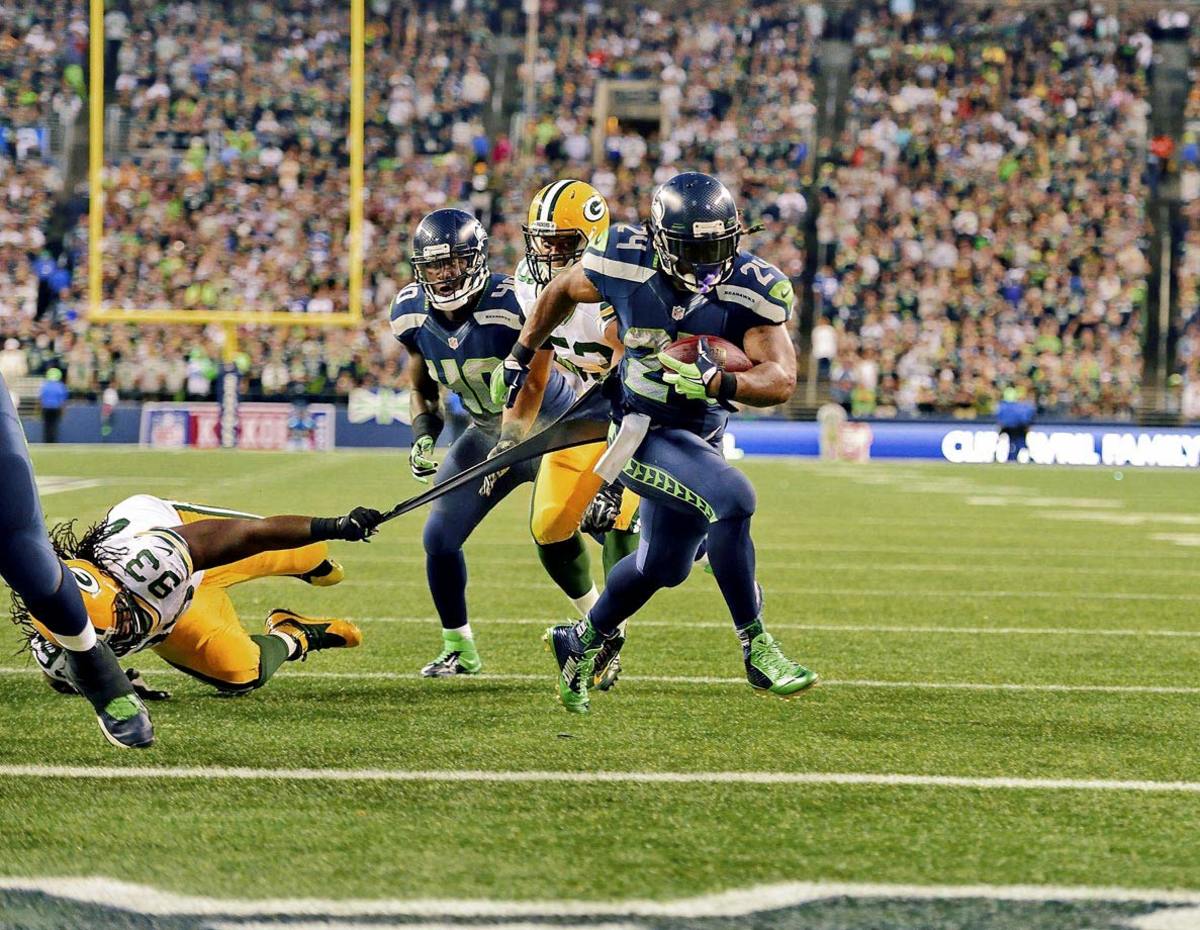
Lynch didn't lead the NFL in rushing yards last season—he finished fourth with 1,306 regular-season yards—but it's difficult to imagine a back more important to his team. His ability to move through defenders is one of his most underrated attributes, and the way he defies contact and gains extra yardage after first contact is unparalleled.
2. Le'Veon Bell, Steelers
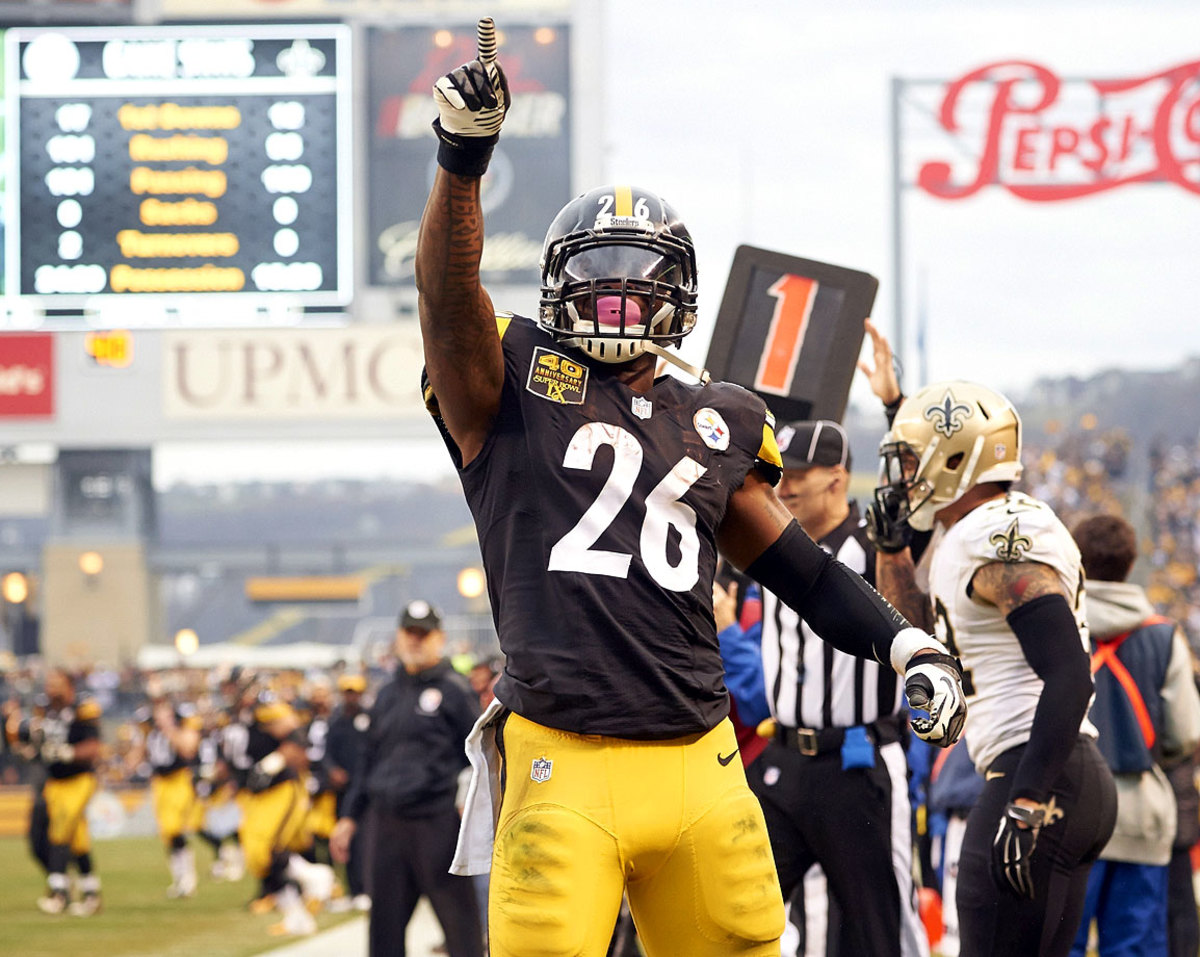
Though the Steelers will go as far as Ben Roethlisberger will take them at this point, Bell is right up there with receiver Antonio Brown as the team's second-most important player. Ever since the Steelers took him in the second round of the 2013 draft, his main attribute has been his patience when waiting for holes to open up, and when he does get back on the field after a two-game suspension to start 2015, he'll continue to power the ground game.
3. DeMarco Murray, Eagles
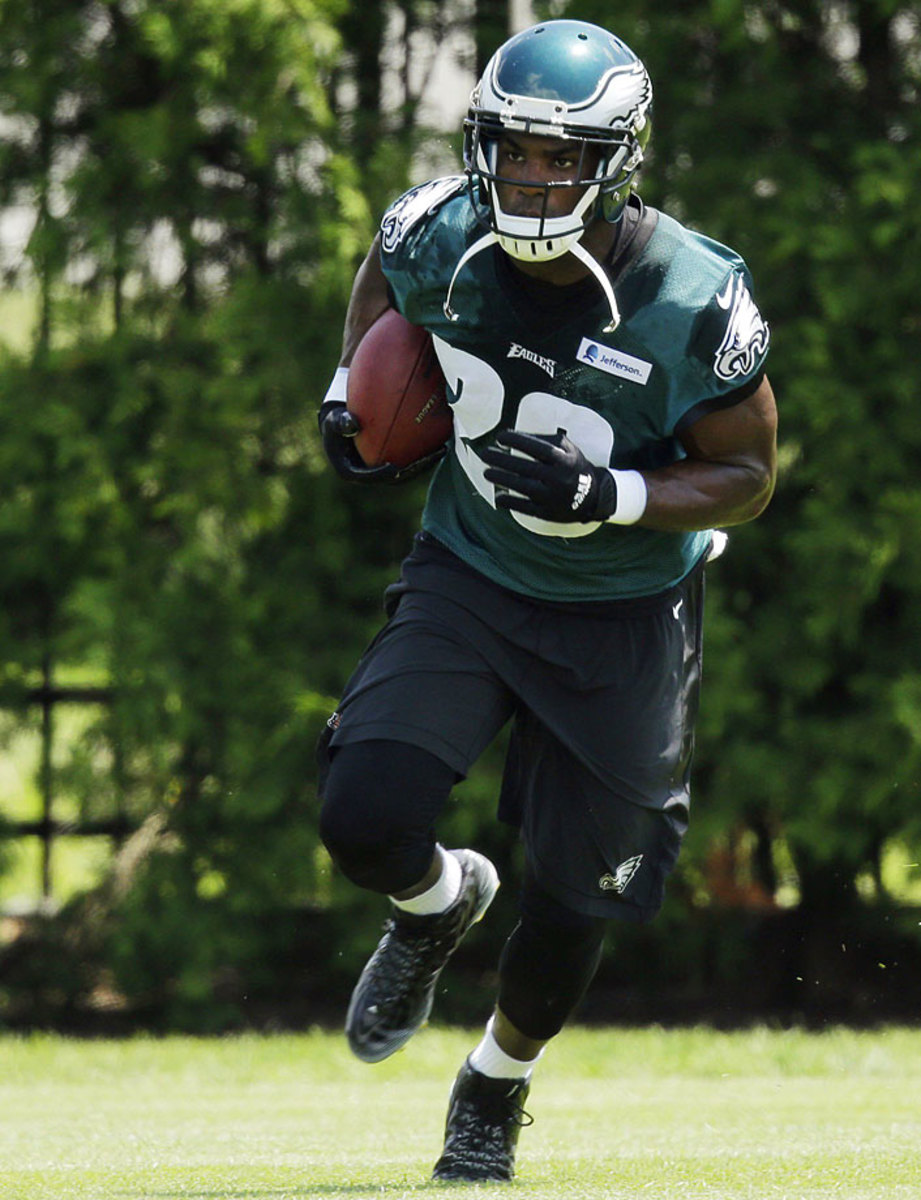
Murray led the league with 1,845 rushing yards in 2014, but according to some, he left a lot of big plays on the field and almost entirely benefited from Dallas's outstanding offensive line. In truth, Murray did a lot to make his line look good, as well—he finished second behind Marshawn Lynch with 77 missed tackles caused in 2014, and he's always been a more powerful runner than his 6'0", 214-pound frame might indicate.
4. Eddie Lacy, Packers
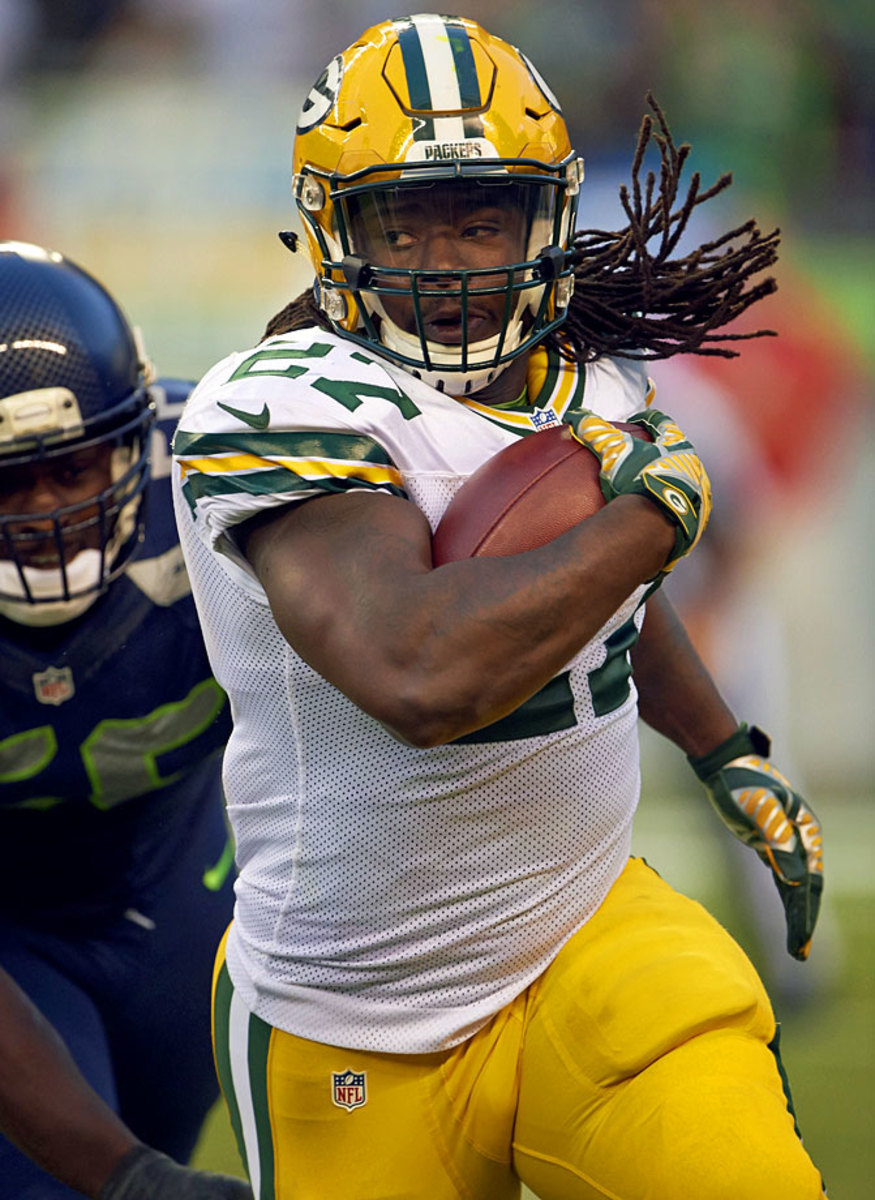
The 5'11", 231-pound Lacy is primarily a power back, but there's some burst in what he does as well. Last season, he finished second in the league with 20 runs of 15 yards or more, behind only DeMarco Murray. Packers coach Mike McCarthy has said he wants to keep Lacy fresh by limiting his rushing attempts in 2015, but don't expect his value to decrease—more and more, Rodgers is relying on Lacy as an option in the passing game, and that could take a serious uptick this season.
5. Jeremy Hill, Bengals
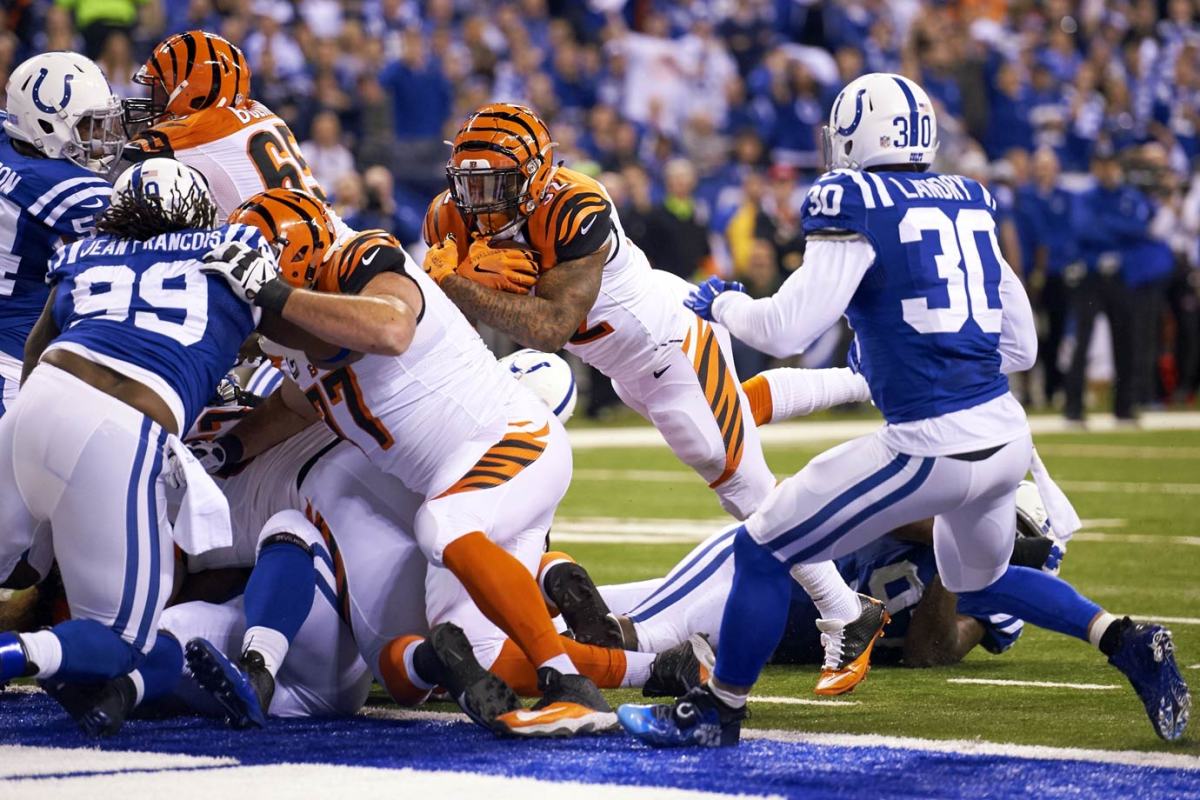
It didn't take long for the second-round rookie to blast off in Cincinnati's offense once he jumped out of the rotational role—in the second half of the 2014 season, no back rushed for more yards than Hill's 929. The 6'1", 233-pound LSU alum has a perfect combination of first-level power and second-level burst, and he very well could be the NFL's next great running back.
6. Jamaal Charles, Chiefs
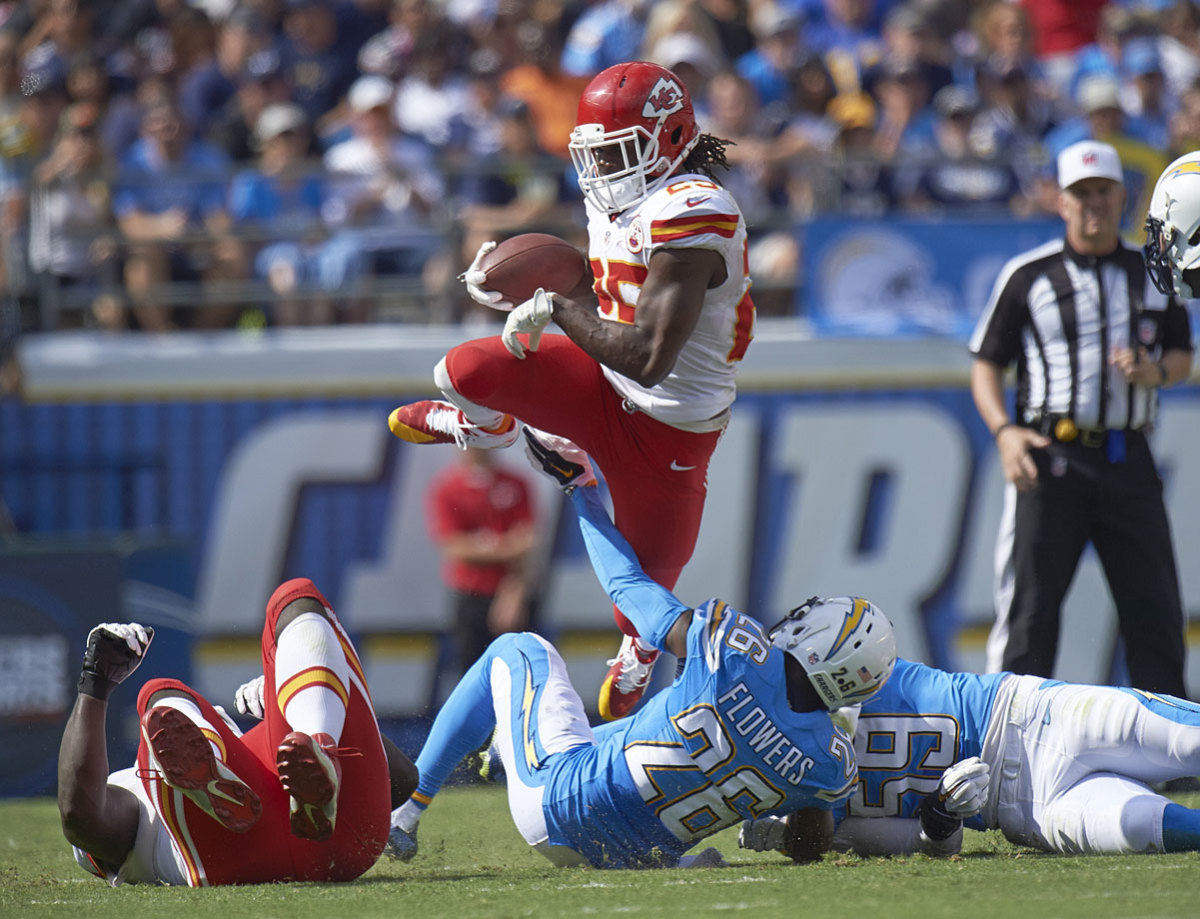
Charles is often incorrectly perceived as an upright, straight-line speed runner. In truth, Charles can bull through the line when necessary, but why do that when you can juke a linebacker out of his shoes and make a cornerback look like he's running in wet cement? Charles has been doing this since he entered the league in 2008.
7. Arian Foster, Texans
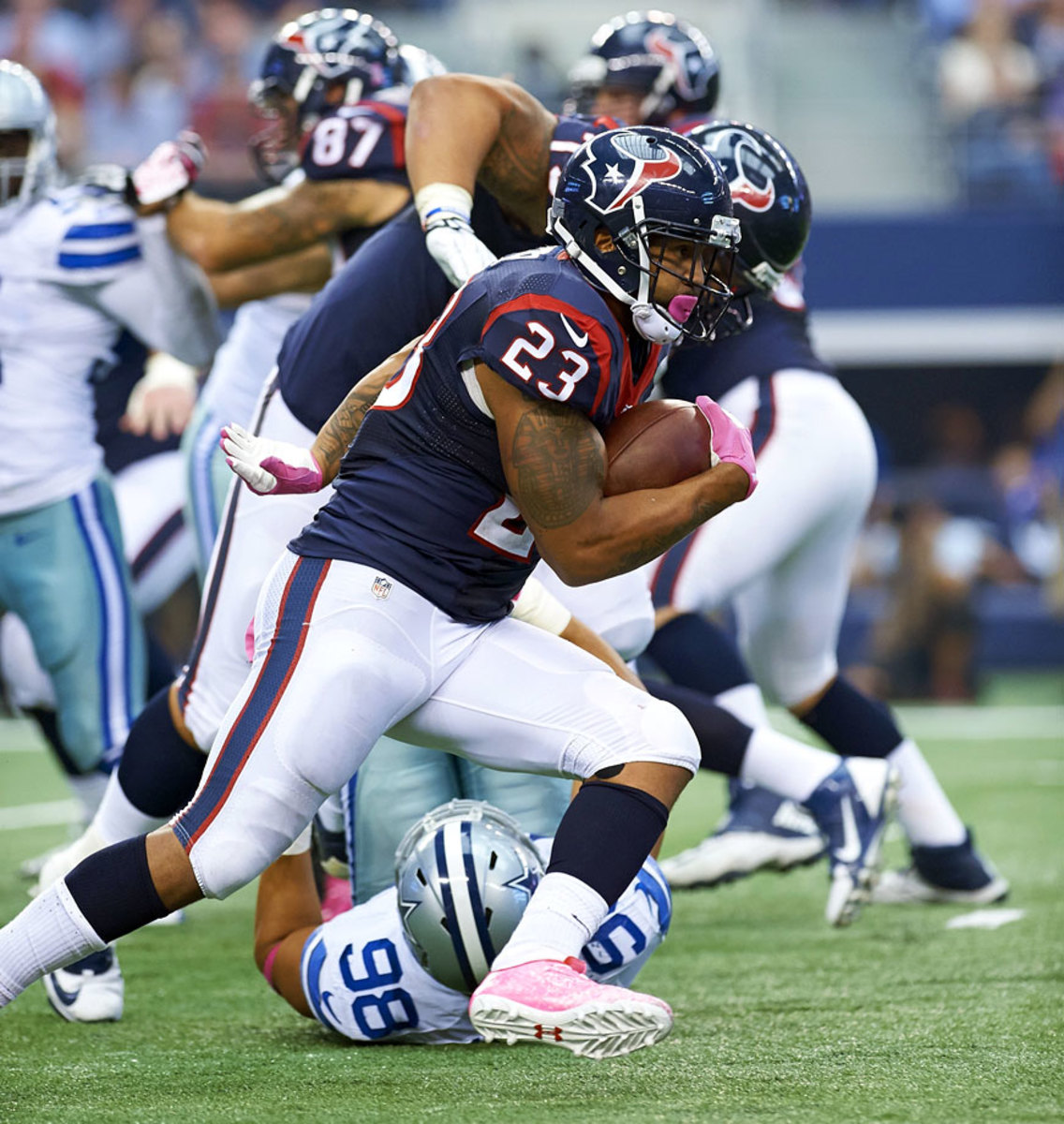
Foster gained 1,246 yards in 2014, despite a horrible quarterback situation, an inconsistent offensive line and injuries that kept him out of three games. Coach Bill O'Brien has said that as long as the 28-year-old Foster has what it takes, he'll get the ball as often as possible.
8. Justin Forsett, Ravens
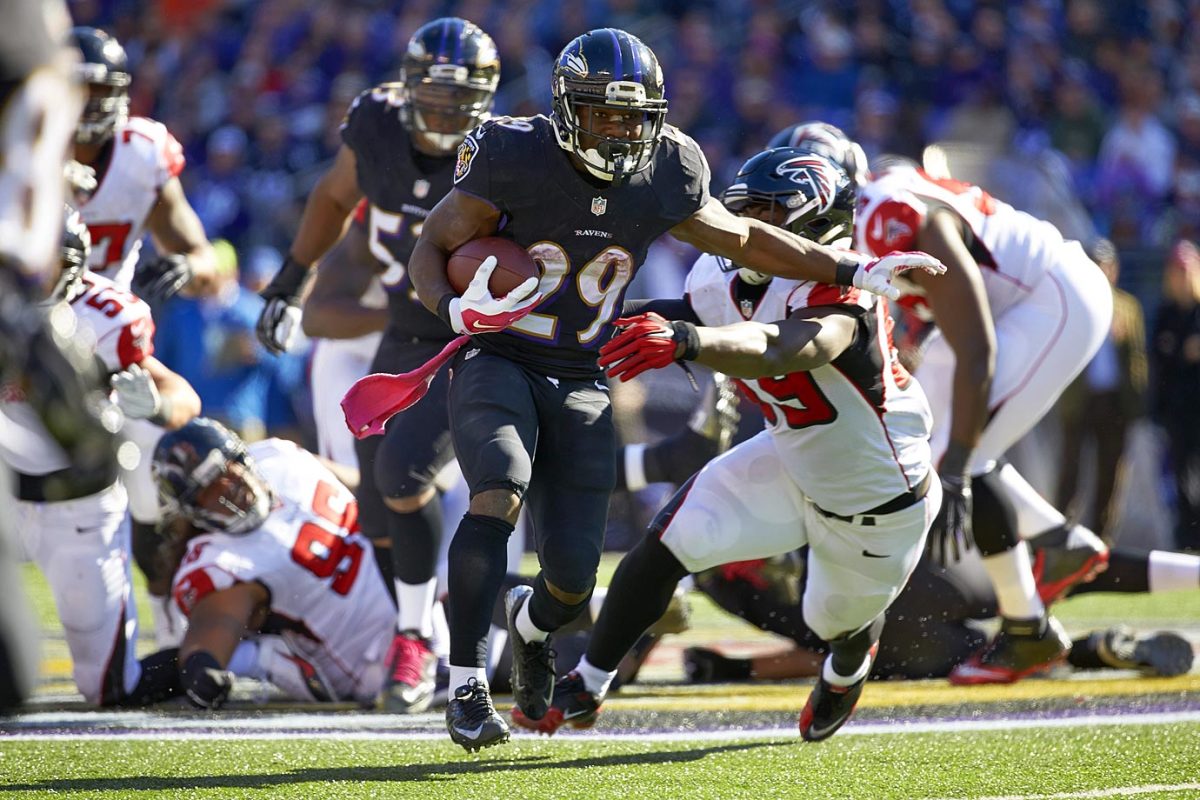
Forsett ran for 1,266 yards and eight touchdowns on just 235 carries in 2014, which isn't bad for a guy whose previous high was 619 yards with the 2009 Seahawks. Forsett is now Baltimore's main back, and he has a nice skill set—surprising power for his size, patience through gaps, and impressive second-level acceleration.
9. Lamar Miller, Dolphins
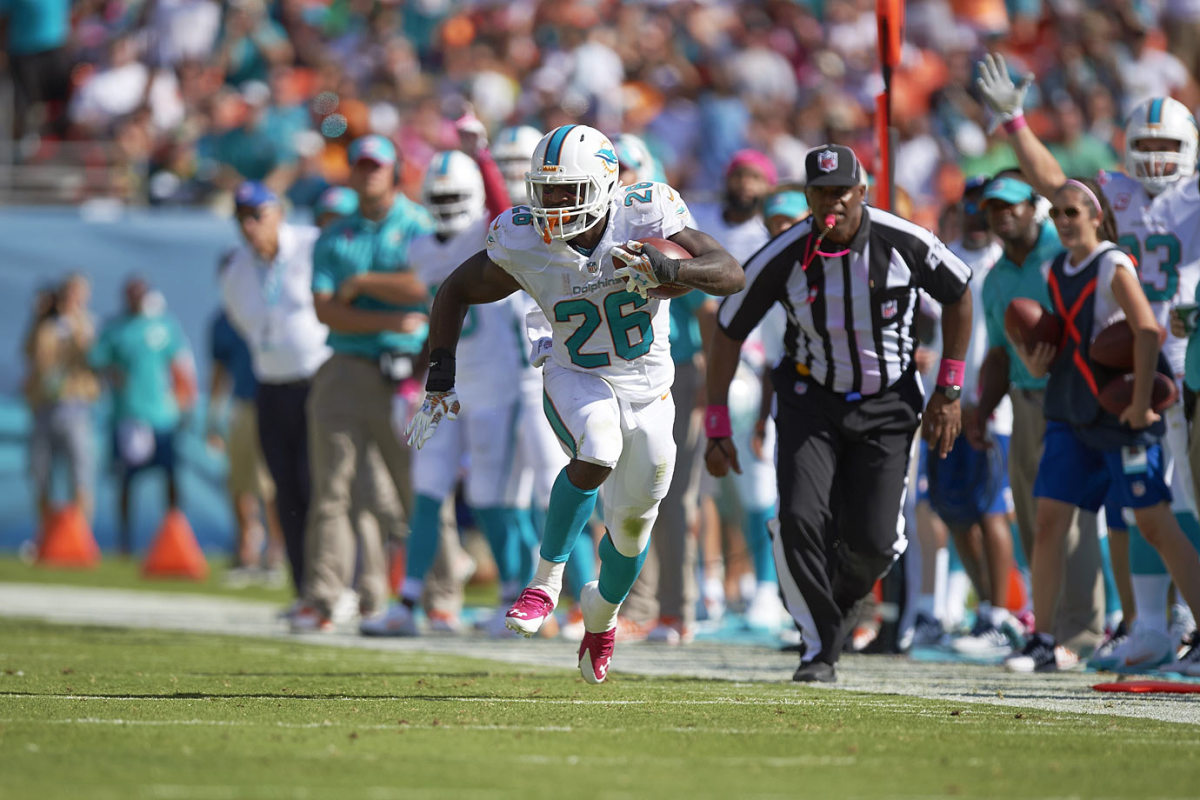
The hype on Miller came true in 2014, when he rushed for 1,099 yards and eight touchdowns on just 216 carries, including a 97-yard run against the Jets in the regular-season finale. Not a bad total for a guy who never had 20 carries in a single game. Miller put on 15 pounds of muscle in the offseason, so he's certainly making his case to be the Dolphins' bell-cow back.
10. Adrian Peterson, Vikings
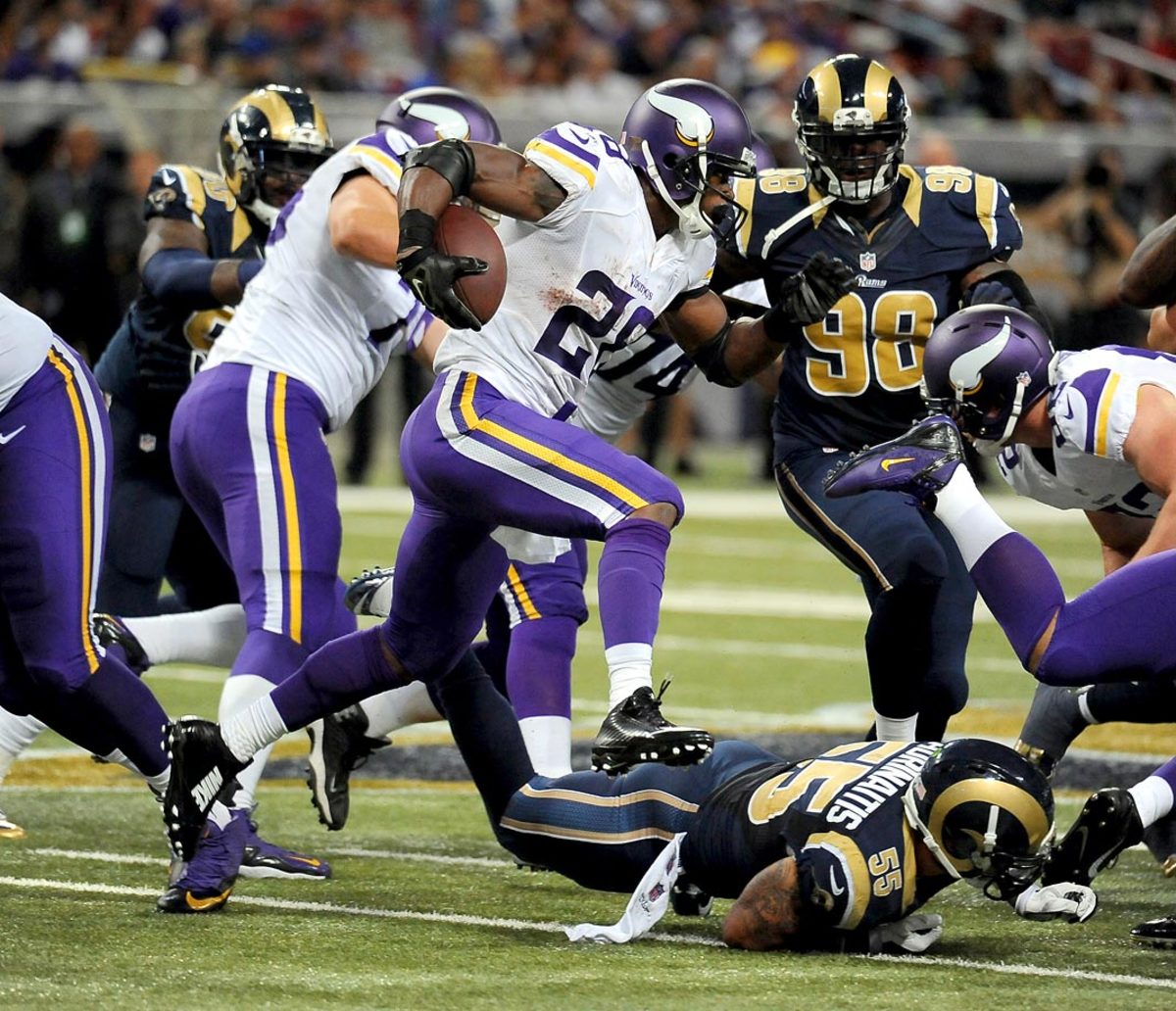
The great unknown. Should Peterson be higher on this list, given his amazing career accomplishments, and the fact that he ran for nearly 1,300 yards in 2013? The year off due to off-field issues is why we have him this low. Also, Peterson turned 30 in March, and that's a bad place to be for any running back.
